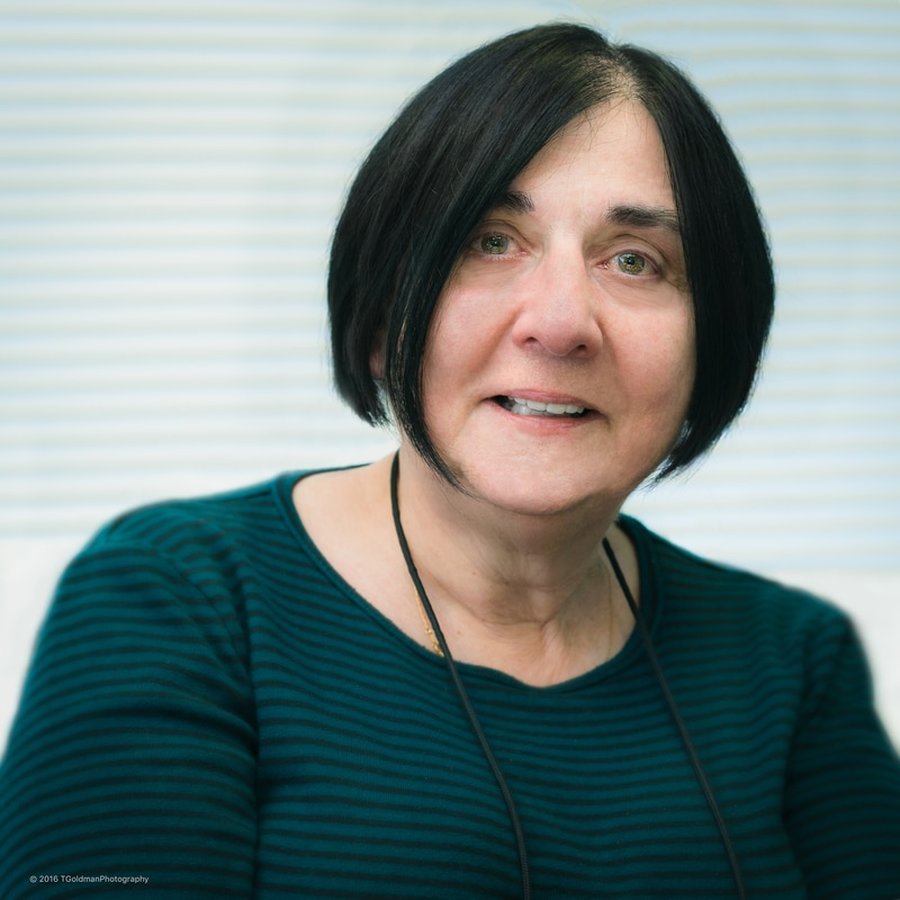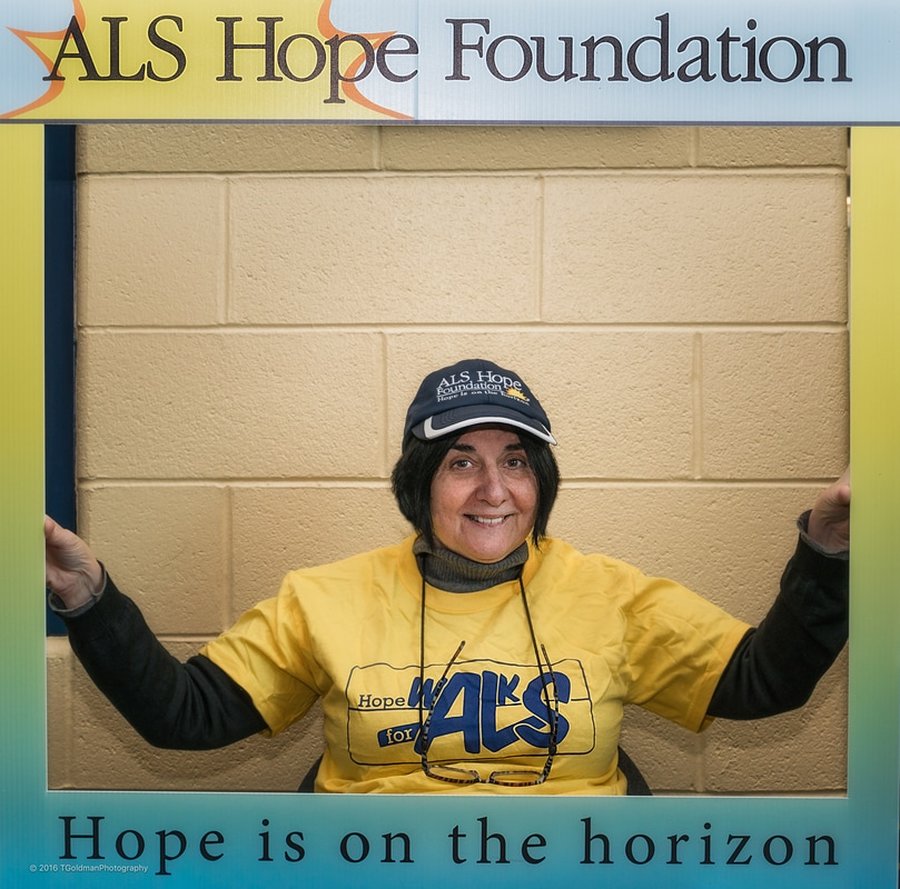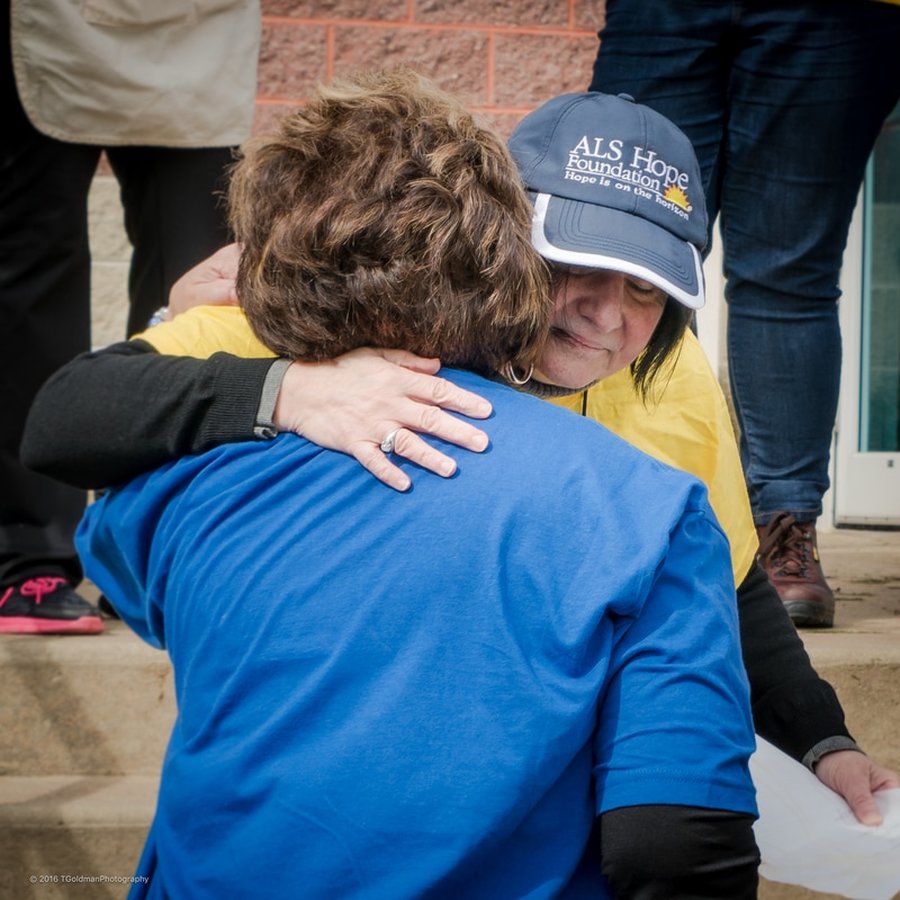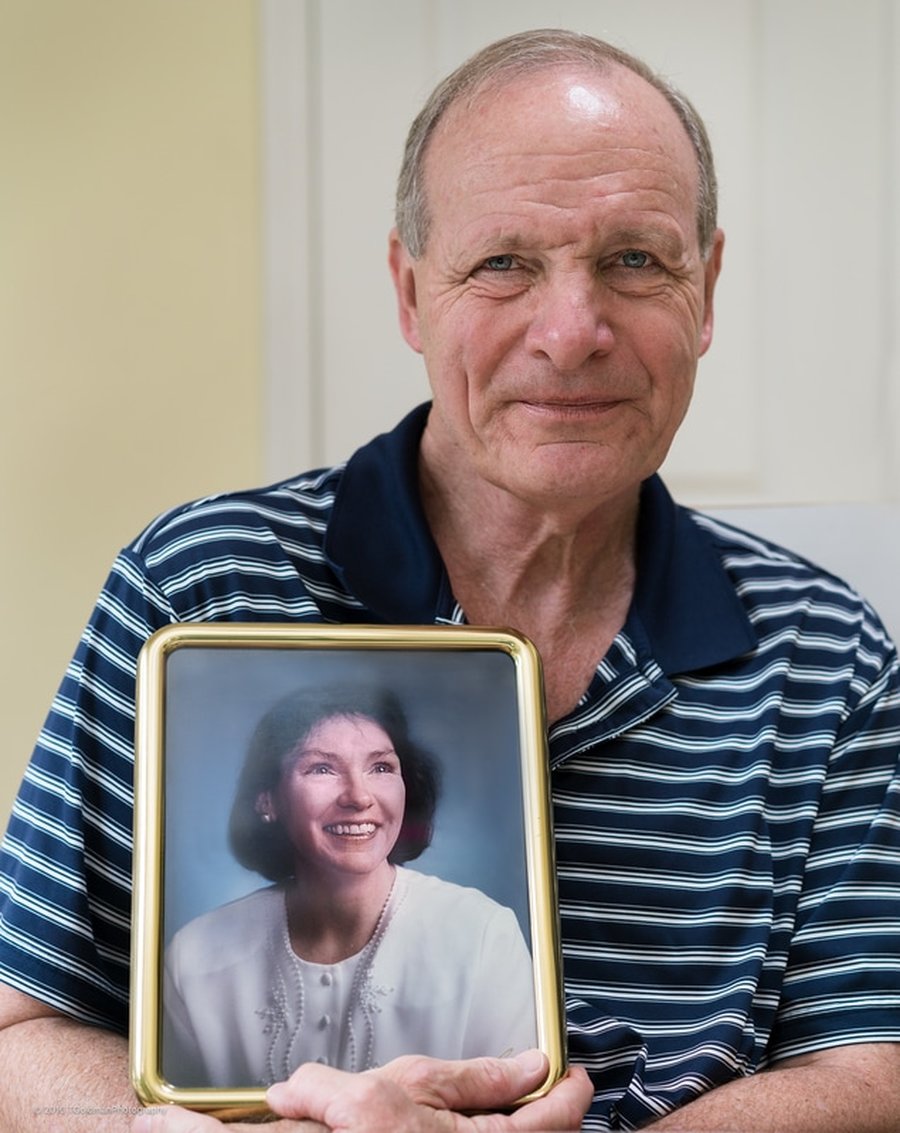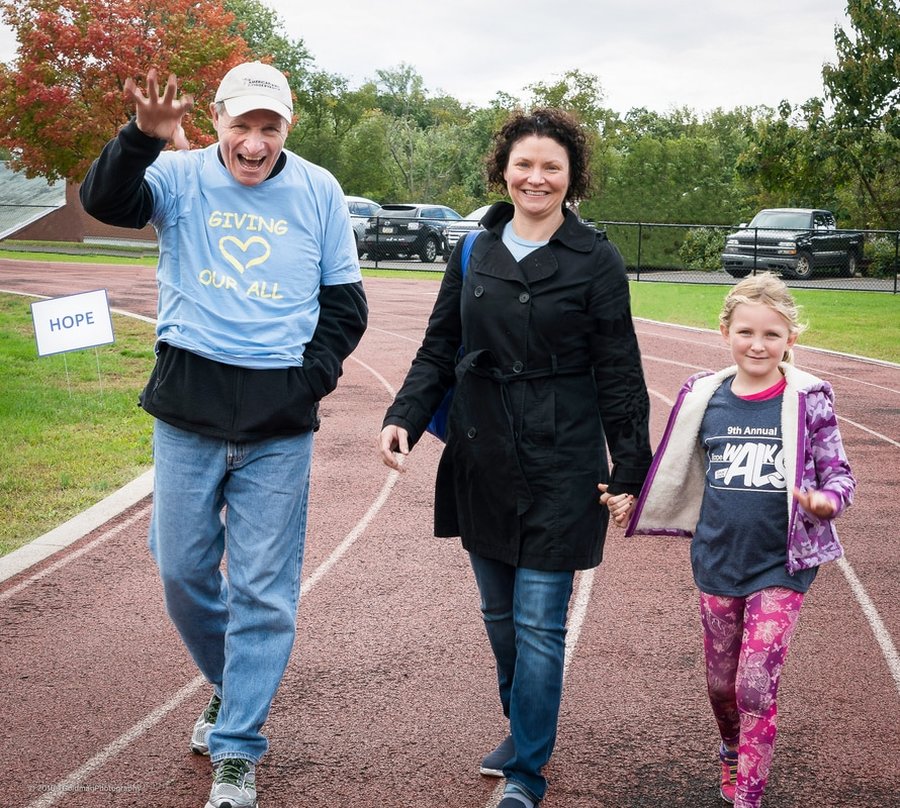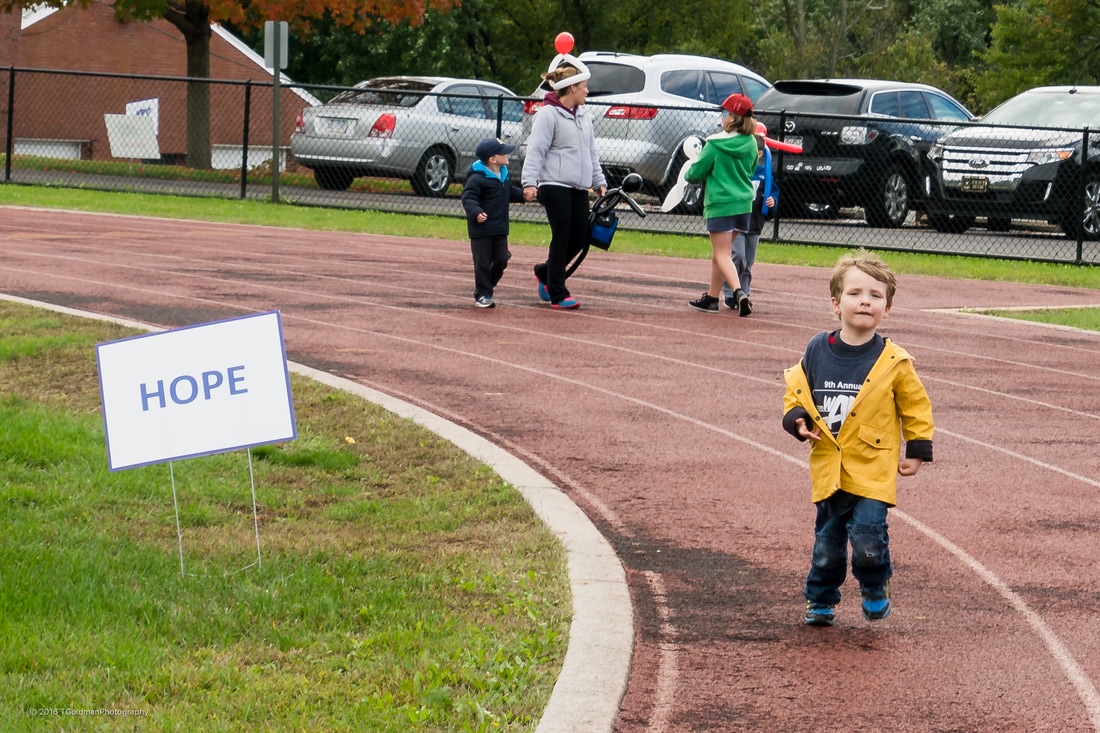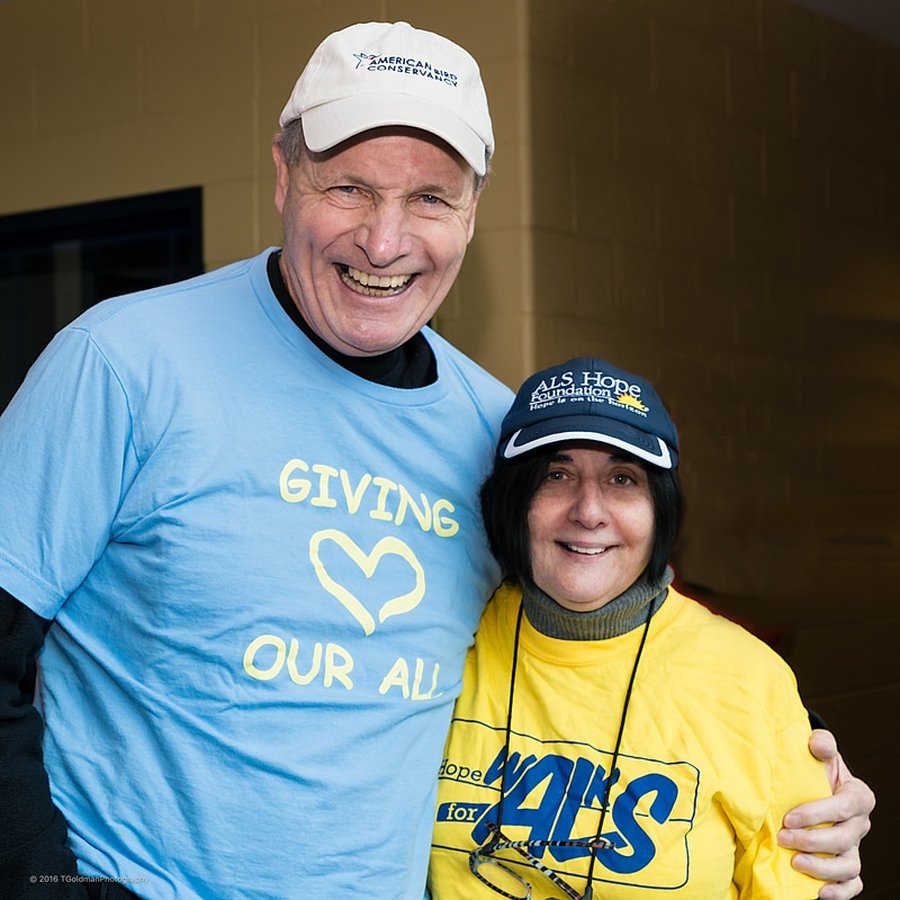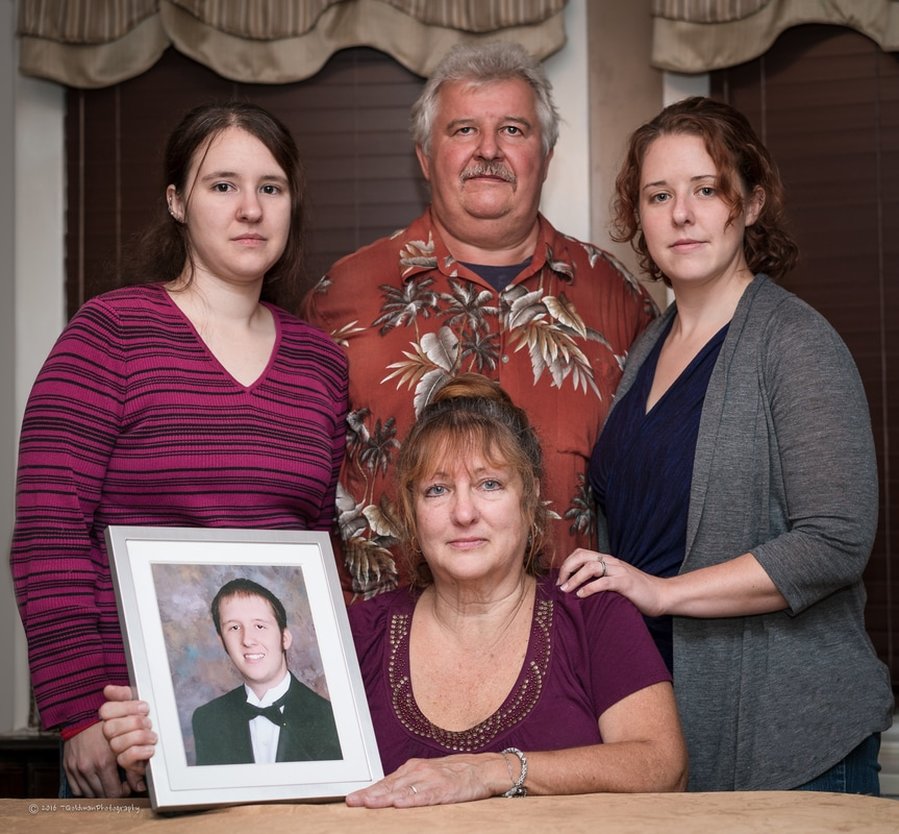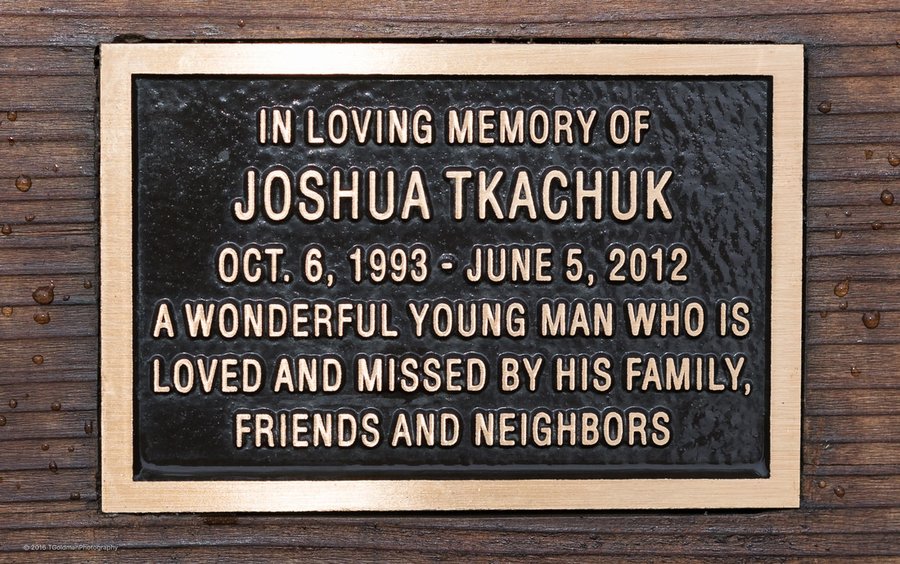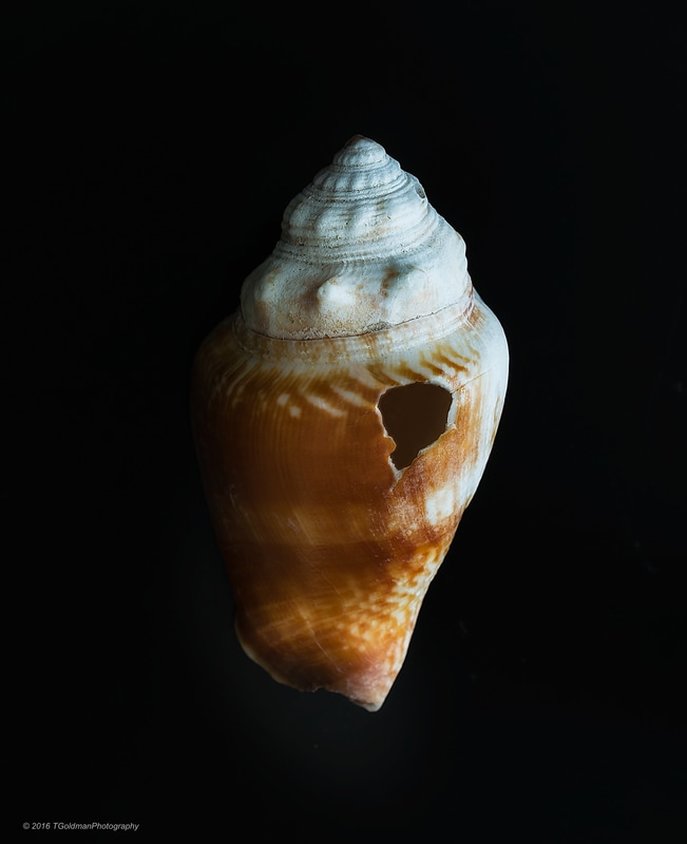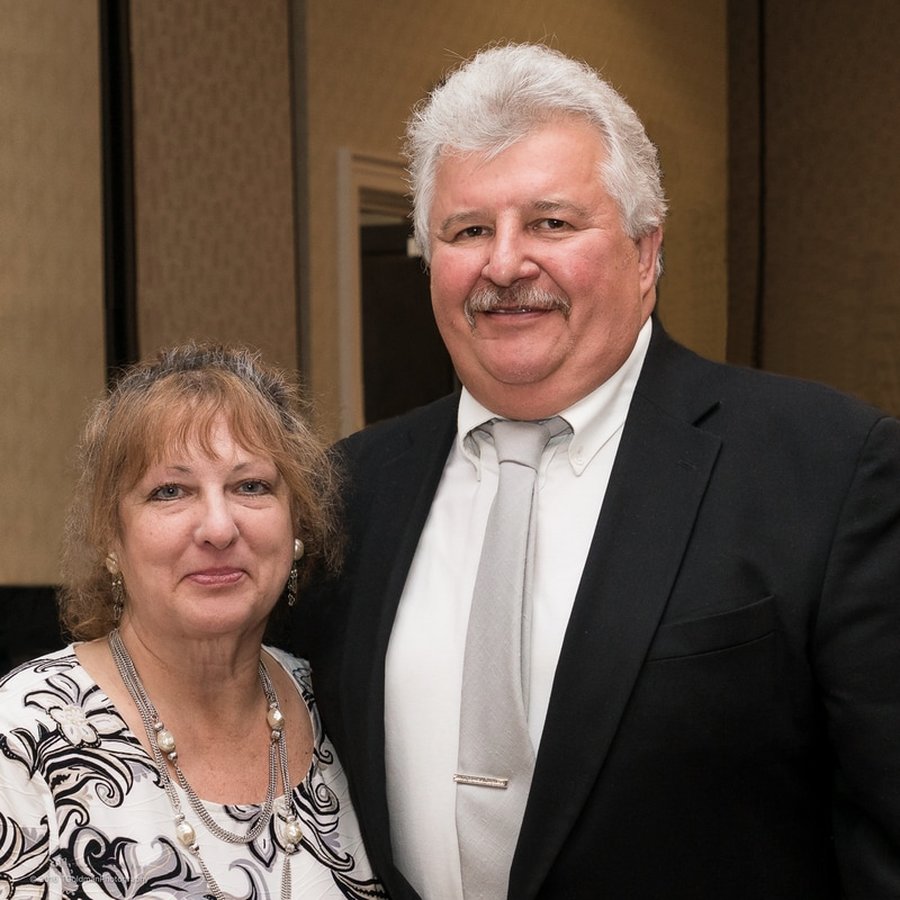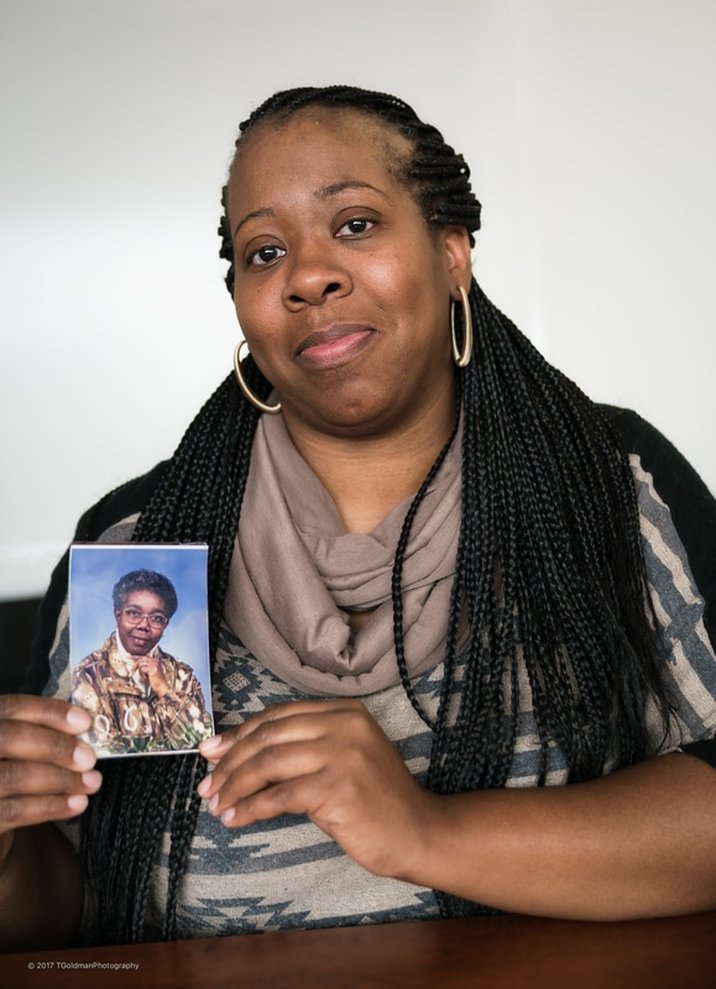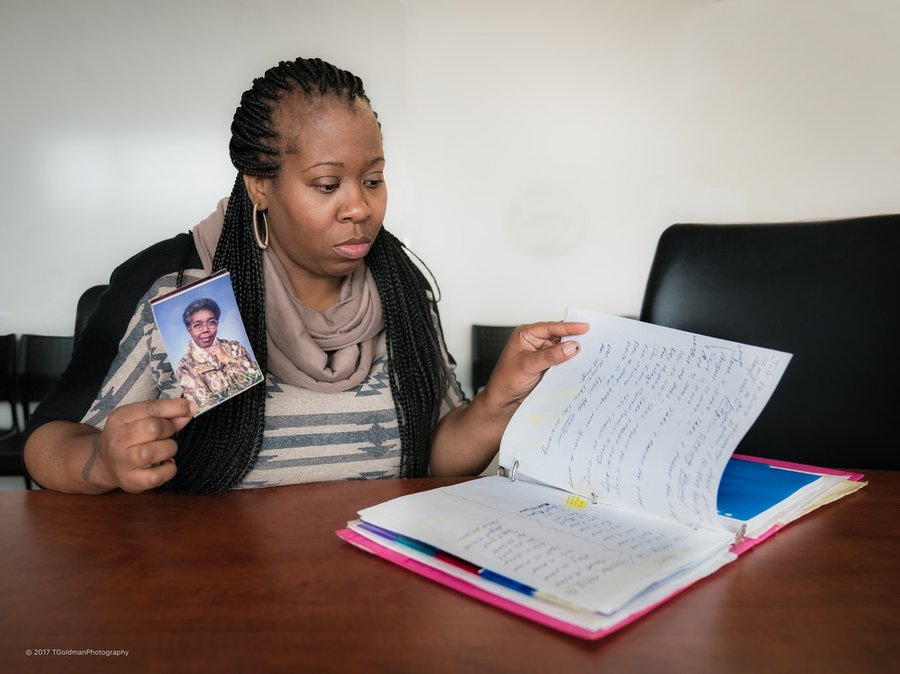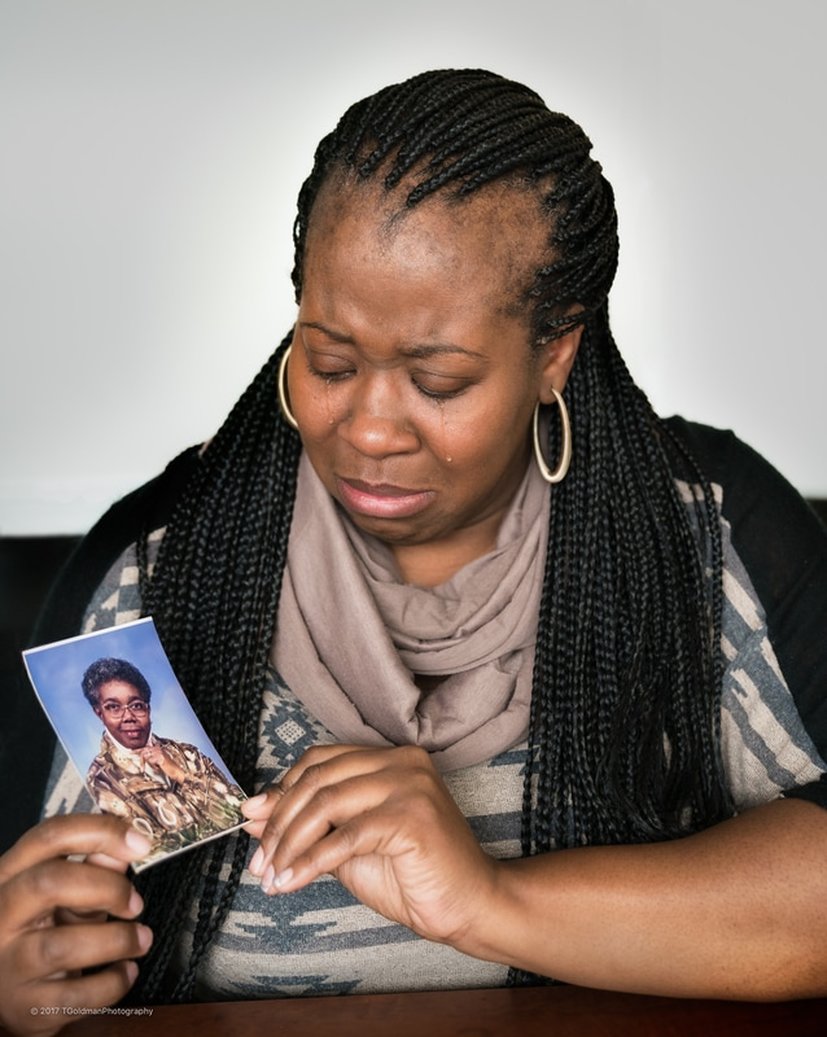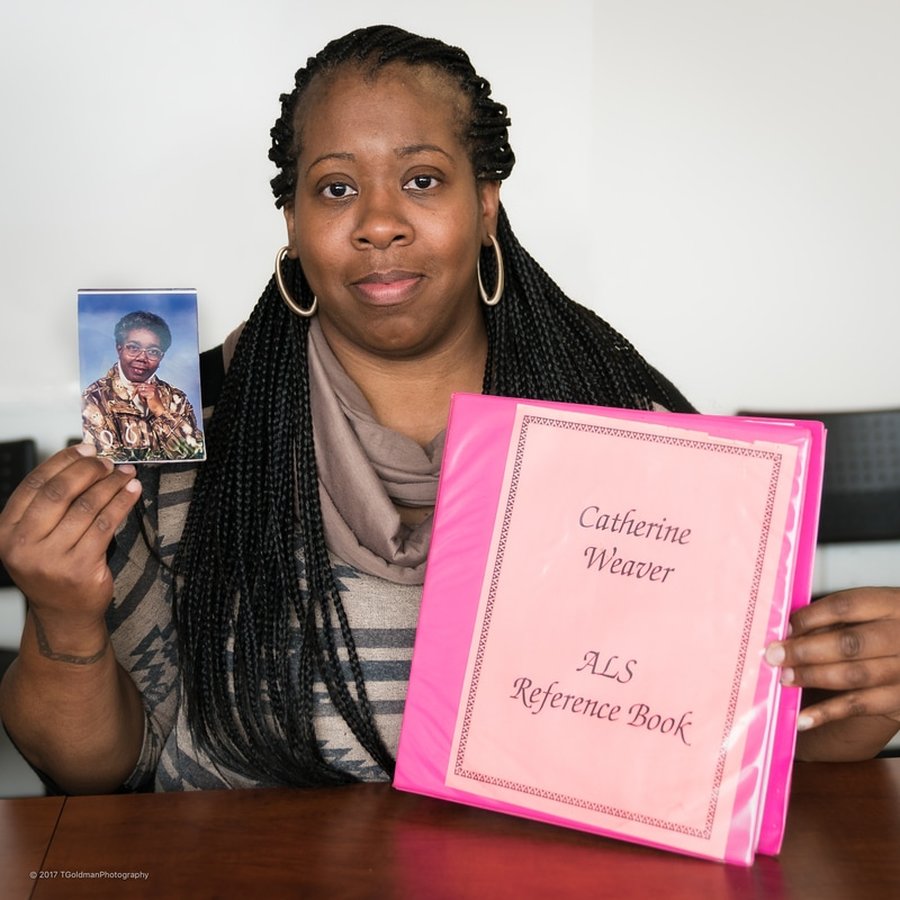People of ALS: Having Hope
Preface
The goal of my photo essays is to present important topics that people need to know more about. One area of interest is showing the truth about diseases the public doesn't understand. The first was “Living with MS” in 2014. In 2017, it’s ALS.
I had a chance meeting with Sara Feldman, a physical therapist at the MDA/ALS Center of Hope in Philadelphia. I knew ALS, which used to be called Lou Gehrig’s disease, was a terrible disease. I remembered the 1998 broadcast of CBS’s 60 Minutes where Jack Kevorkian administered a lethal injection to an ALS patient that would end his suffering. And there was the ALS Ice Bucket Challenge which was a tremendous fund raiser, but did little to educate the public about the disease. So when I met Sara, I knew I needed to do this story and I’m glad she and her colleagues agreed.
In developing this story, I learned two important and almost contradictory facts about ALS. It is a cruel disease which rapidly destroys the body while leaving the mind intact. Once diagnosed, this death sentence does its work quickly while imposing extreme physical changes and deterioration along with emotional pain on both victims and families. But I also learned that within the ALS community, there is a remarkable degree of hope. This became evident through getting to know the ALS Hope Foundation and the MDA/ALS Center of Hope located at Temple University’s Lewis Katz School of Medicine. I realized that along with exploring the horror of ALS, I also needed to explore the hope.
Introduction
It’s not the purpose of this photo essay to delve into the medical details of ALS, but rather to delve into the impact on people who live with this disease. The idea for "People of ALS" started with Sara Feldman’s comment that “ALS is a family disease!” It’s not just the patient who suffers from ALS, but also the family who often becomes the primary caregiver and deals with the ultimate loss. I learned there are other people as well. One day spent with patients at the MDA/ALS Center of Hope clinic showed that professionals are every bit as invested in this disease as are the patients and their families. This photo essay is a portrait of two very important "People of ALS": the professional and the family who has lost a loved one to ALS.
But this is not to say there are only two types of "People of ALS" beyond the patient. There are many more including administrators who run ALS organizations and manage fundraising, researchers who work to understand the cause of ALS, researchers who develop drug therapies and manage clinical trials, and of course the public who supports the ALS community.
My hope is that through the experiences of these "People of ALS", the public will get insight into the tremendous human impact of this disease.
The Professional:
Dr. Terry Heiman-Patterson
There is no better way to exemplify the professional than presenting “Dr. Terry”. She is Professor of Neurology at Temple University’s Lewis Katz School of Medicine, Co-Founder and President of the ALS Hope Foundation, Director of the MDA/ALS Center of Hope, including clinical and laboratory research programs, and Co-Chairman of the Northeast ALS Consortium. She has published more than ninety papers, abstracts, and chapters on ALS and related motor neuron diseases.
Simply stated, she is a world leader in the fight to end ALS and to bring hope to the care and treatment of patients. Dr. Terry is a PRO like no other- a force of nature.
Terry committed to medicine at an age when most of us were playing in the sandbox, and rocketed to a faculty position in neurology by her late 20’s. She is waging a war against an enemy that takes away the lives of its victims and their families, and does so in the most painful way- that’s ALS. During almost thirty years she has helped thousands of people and there is no sign of her slowing down.
She tears up when speaking about her life dedication to ALS- “I always try to quietly make a difference by doing what needs to be done to help patients; I just want everything to be done the right way for people living with this disease; I want to know my having been here made a difference to people living with ALS and that the next generation of people who get ALS will be better off because of the things I did and tried to accomplish… I can’t do enough- the urgency is so palpable because I see it every day.” In spite of her eighty hour work week, Terry has managed to have a family- a husband, two daughters and a son who all support her cause.
Terry was just twenty seven when she was introduced to the human tragedy of ALS: “A colleague asked me to see a young woman who they thought had ALS: ‘I’d like you to take care of her- see what you think and tell her what she has’; that was code for: ‘I can’t deal with it’, because in those days we had nothing to offer.”
“For Cathy (Terry will never forget her name) it started with weakness in her arms and difficulty speaking; she was in intensive care and close to needing a ventilator; I was so young for such a heavy task; I told her this disease affects motor nerve cells and we don’t have cure but we can try to help… When she realized her condition would progress, she said: ‘I’m 38 years old; our children are going to graduate from high school next year and my husband and I are planning a second honeymoon, and now you're telling me I’ll never hold my husband again’.”
“I went home and had this vision that ALS is an anvil and I have a hammer, and I’m just going to bang away at it”…. (She tears up and her voice cracks): “That was the defining moment for what I would do the rest of my life and at sixty five I’m banging away at ALS harder than ever!”
The Basics of ALS (amyotrophic lateral sclerosis) from the ALS Hope Foundation website: "ALS is a degenerative neurological disease that leads to progressive weakness. ALS does not discriminate on the basis of race, religion, gender, nationality, or economic status. The cause of ALS is still unknown, and there is no cure... However, there is 'hope'."
“Anyone from eighteen to ninety eight can get ALS, but it’s typically fifty to sixty year olds with men being a bit more susceptible; lifespan averages just twenty four to thirty six months; it’s estimated there are 20,000-30,000 people in the U.S. who have ALS.”
One might argue ALS is just a minor disease in terms of the numbers, but it’s the devastation, lack of a cure and certain fate of an ALS diagnosis that magnifies its importance as something that needs to be stopped in its tracks. ALS has a similar incidence rate as does Multiple Sclerosis, but the number of people with ALS at any one time is much lower because life expectancy is so short.
Terry described the human impact of ALS: “It’s devastating- patients struggle with their disease; families struggle to take care of their loved ones and I struggle to get funding to keep our clinic and research going… ALS is a nightmare- patients become unable to move, unable to talk… It’s a moving target- everyday there is a new change, week to week and month to month; every time you accommodate to a level of function, first thing you know you’ve lost another function… We need technology that can adapt rapidly; if a patient has to wait six months to get a power wheel chair, by that time they won’t be able to use the joystick."
The impact on the family can’t be underestimated: “The spouse has to work to maintain insurance but then who helps the patient at home; how do you put together a care plan which doesn't leave the patient feeling like burden; and how do you maintain a loving spousal relationship and not a caregiver patient relationship- that intimacy is so important for quality of life… After the patient passes, then comes the guilt- spouses will say: ‘I remember the time we argued and I yelled at Joe because he was asking me for too much and he didn't let me sit down for a minute; even if he was nasty to me, I should have been more understanding’… The living spouse feels guilty about being the one who lived and guilty that the kids didn't get enough attention because they were so busy caregiving.”
Terry thinks strategically about ALS and shows her frustration that diseases like ALS get overlooked even when solutions are available: “I wish I could shake people up that this is important and the things we can do for ALS patients are translatable to other chronic diseases; if technology is available we need to enable people to use it; make it happen faster and keep insurance companies from putting up roadblocks; if people develop technology, allow it to be used by ALS patients rather than saying: ‘It can’t be patented or we can’t make money’… ALS is about people and their suffering, NOT about profit!”
Of Terry’s many accomplishments, most significant is the 1984 launch of the first multidisciplinary ALS clinic in the country to treat patients and conduct clinical trials. The MDA/ALS Center of Hope provides a broad range of clinical services to patients who spend a half day there each quarter: “There are more than one hundred clinics like ours with directors who care as much as I do, and they are all challenged to get funding… The ALS Hope Foundation allows people to donate to a local clinic which directly treats patients.”
“Insurance doesn't cover most of the cost to visit the clinic, so we have to; it’s so important because it’s been shown that multidisciplinary clinics improve the quality of lives and patients live longer… I spend so much time scrambling for money which keeps me from devoting all my time to patients and research.”
The first time I visited the MDA/ALS Center of Hope clinic it was clear this was no ordinary doctor’s office. Remarkably, these patients are upbeat! “That’s the HOPE; we don’t tell people to go home and die, though some clinics do; we make this about living; we treat patients like family… Young doctors are taught not to get too close to the patient, but if you’re going to give compassionate medicine, you have to think about how I would want my family to be treated; I want these people to know we care about them; I want to know about their kids; I’m so proud of my team.”… Terry and staff members actually go to patient’s funerals when they can: “It shows the family we really care and we wish it could have turned out differently.”
Both the foundation and the clinic have the word “hope” in their titles- can there really be hope for a disease which seems to have no hope?: “There is tons of hope- absolutely!… Thirty years ago there were no clinical trials and no drugs, but now there are constant trials and real targets; I don’t have a cure yet but I do have a drug that slows it down… We’re going to be talking cures and real progress on the genetic forms of ALS; there is tons of hope and it will be cured; that means doing something for people who have the disease; it also means identifying genes so we can prevent ALS from happening at all- these days are here now… But here’s the problem- the patients I’m seeing today have thirty six months, so these discoveries I make won’t be for them!”
Terry was just twenty seven when she was introduced to the human tragedy of ALS: “A colleague asked me to see a young woman who they thought had ALS: ‘I’d like you to take care of her- see what you think and tell her what she has’; that was code for: ‘I can’t deal with it’, because in those days we had nothing to offer.”
“For Cathy (Terry will never forget her name) it started with weakness in her arms and difficulty speaking; she was in intensive care and close to needing a ventilator; I was so young for such a heavy task; I told her this disease affects motor nerve cells and we don’t have cure but we can try to help… When she realized her condition would progress, she said: ‘I’m 38 years old; our children are going to graduate from high school next year and my husband and I are planning a second honeymoon, and now you're telling me I’ll never hold my husband again’.”
“I went home and had this vision that ALS is an anvil and I have a hammer, and I’m just going to bang away at it”…. (She tears up and her voice cracks): “That was the defining moment for what I would do the rest of my life and at sixty five I’m banging away at ALS harder than ever!”
The Basics of ALS (amyotrophic lateral sclerosis) from the ALS Hope Foundation website: "ALS is a degenerative neurological disease that leads to progressive weakness. ALS does not discriminate on the basis of race, religion, gender, nationality, or economic status. The cause of ALS is still unknown, and there is no cure... However, there is 'hope'."
“Anyone from eighteen to ninety eight can get ALS, but it’s typically fifty to sixty year olds with men being a bit more susceptible; lifespan averages just twenty four to thirty six months; it’s estimated there are 20,000-30,000 people in the U.S. who have ALS.”
One might argue ALS is just a minor disease in terms of the numbers, but it’s the devastation, lack of a cure and certain fate of an ALS diagnosis that magnifies its importance as something that needs to be stopped in its tracks. ALS has a similar incidence rate as does Multiple Sclerosis, but the number of people with ALS at any one time is much lower because life expectancy is so short.
Terry described the human impact of ALS: “It’s devastating- patients struggle with their disease; families struggle to take care of their loved ones and I struggle to get funding to keep our clinic and research going… ALS is a nightmare- patients become unable to move, unable to talk… It’s a moving target- everyday there is a new change, week to week and month to month; every time you accommodate to a level of function, first thing you know you’ve lost another function… We need technology that can adapt rapidly; if a patient has to wait six months to get a power wheel chair, by that time they won’t be able to use the joystick."
The impact on the family can’t be underestimated: “The spouse has to work to maintain insurance but then who helps the patient at home; how do you put together a care plan which doesn't leave the patient feeling like burden; and how do you maintain a loving spousal relationship and not a caregiver patient relationship- that intimacy is so important for quality of life… After the patient passes, then comes the guilt- spouses will say: ‘I remember the time we argued and I yelled at Joe because he was asking me for too much and he didn't let me sit down for a minute; even if he was nasty to me, I should have been more understanding’… The living spouse feels guilty about being the one who lived and guilty that the kids didn't get enough attention because they were so busy caregiving.”
Terry thinks strategically about ALS and shows her frustration that diseases like ALS get overlooked even when solutions are available: “I wish I could shake people up that this is important and the things we can do for ALS patients are translatable to other chronic diseases; if technology is available we need to enable people to use it; make it happen faster and keep insurance companies from putting up roadblocks; if people develop technology, allow it to be used by ALS patients rather than saying: ‘It can’t be patented or we can’t make money’… ALS is about people and their suffering, NOT about profit!”
Of Terry’s many accomplishments, most significant is the 1984 launch of the first multidisciplinary ALS clinic in the country to treat patients and conduct clinical trials. The MDA/ALS Center of Hope provides a broad range of clinical services to patients who spend a half day there each quarter: “There are more than one hundred clinics like ours with directors who care as much as I do, and they are all challenged to get funding… The ALS Hope Foundation allows people to donate to a local clinic which directly treats patients.”
“Insurance doesn't cover most of the cost to visit the clinic, so we have to; it’s so important because it’s been shown that multidisciplinary clinics improve the quality of lives and patients live longer… I spend so much time scrambling for money which keeps me from devoting all my time to patients and research.”
The first time I visited the MDA/ALS Center of Hope clinic it was clear this was no ordinary doctor’s office. Remarkably, these patients are upbeat! “That’s the HOPE; we don’t tell people to go home and die, though some clinics do; we make this about living; we treat patients like family… Young doctors are taught not to get too close to the patient, but if you’re going to give compassionate medicine, you have to think about how I would want my family to be treated; I want these people to know we care about them; I want to know about their kids; I’m so proud of my team.”… Terry and staff members actually go to patient’s funerals when they can: “It shows the family we really care and we wish it could have turned out differently.”
Both the foundation and the clinic have the word “hope” in their titles- can there really be hope for a disease which seems to have no hope?: “There is tons of hope- absolutely!… Thirty years ago there were no clinical trials and no drugs, but now there are constant trials and real targets; I don’t have a cure yet but I do have a drug that slows it down… We’re going to be talking cures and real progress on the genetic forms of ALS; there is tons of hope and it will be cured; that means doing something for people who have the disease; it also means identifying genes so we can prevent ALS from happening at all- these days are here now… But here’s the problem- the patients I’m seeing today have thirty six months, so these discoveries I make won’t be for them!”
Terry’s big smile at the 2016 Hope Walk for ALS- this dose of hope is her special medicine.
And she is always ready to give a dose of compassion to families when ALS claims a life.
At the end of our interview I could only think of one thing to say to Terry: “You are a hero to your patients and to everyone who suffers from ALS.” But true to form, such a notion didn't compute.
The Family Who Has
Lost a Loved One to ALS
Mike McCool: Husband of Phyllis
Mike caresses a picture of Phyllis as a vibrant and healthy woman- but this wouldn't last.
Almost four years after losing Phyllis, Mike is very much in love- he struggles with emotion as he speaks about her: “I first realized there was something wrong when Phyllis (sixty three years old) was training for the 2011 Philadelphia Distance Run; we ran on a trail and I noticed she was kicking up cinders; I asked her about it, but she hadn't noticed- we thought ‘no big deal’… Two weeks later on the same trail, her socks got all grey with dust; I pointed it out but she still had no idea what was happening… A couple of weeks later we were out for a morning run and after two or three blocks she said: ‘My left leg doesn't want to work right’… She went to a sports medicine doctor who thought it was some sort of nerve palsy or a pinched nerve.” This was July 2011. By August she was having problems with her gait and she started to fall. Their lives were about to begin the rapid descent into the clutches of ALS. She was gone in April 2013.
Phyllis was a nurse working for a local practice in Reading, PA: “She loved her patients and they loved her; we had three daughters and five grand children, three that Phyllis knew- she was comatose when the fourth was born just a week before she died.”
After seeing the sports medicine doctor, they went to a neurologist who initially thought she had Parkinson’s Disease: “But he said ‘Parkinson’s Plus’ because he thought something more was going on; at this point we were getting scared, but the doctor said Parkinson’s is an easy disease- there are lots of therapies and you can live with it for a long time.”
They were sent to a movement specialist at Jefferson University Hospital. He thought there might be two possibilities but was not able to make the diagnosis: “Phyllis had done research and knew it might be ALS; when she told me, I said ‘let’s not think the worst’… But she was getting pretty grim; I tried to reassure her as best I could- I didn’t know enough about it to be scared.” This was July-August, 2011.
Dr. Bonner, the doctor Phyllis worked for, called us in November 2011 after Phyllis had a fall which put her in the ER. Dr. Bonner had already called a colleague at Johns Hopkins and scheduled Phyllis for the following Monday for a neurological workup: “During the various tests, the technicians seemed to be reacting to the results; the next day the doctor came into her room and told us she had ALS- a monumental blow!”
“Phyllis melted.” (Mike tears up as he talks about it)… “We knew exactly what it meant; the doctor said she should go to an ALS clinic which would measure the disease’s progression; he said the average was two to ten years but because she was young and physically strong, she should go for the longer time frame, which didn't happen… We drove home and poured a glass of wine.”
They knew this was terminal. Looking back on it, Mike knew at that moment: “My life was ruined, and our girls would be devastated because they were so close to their mother- the whole family got ALS along with Phyllis.”
The devastating two year progression of Phyllis’ ALS:
- March 2011: Initial running symptoms.
- July 2011: Trouble with legs.
- August 2011: Problems with gait; falling.
- November 2011: ALS diagnosis; using a walker but still working: “I tried to keep her working as long as possible to keep her occupied and not sitting around thinking about her demise- and she really loved her patients and they loved her.”
- Feb 2012: Long term disability: “She was falling too much to continue working.”
- April 2012: “One day she was weeping and I asked her what was wrong: ‘One year ago I ran the April Fool Run, it was my best run and I was on top of the world and today I can’t walk two steps’; I told her: ‘I’m sorry’… I felt every minute of her pain- I felt it then and I still feel it today.”
- May 2012: Power wheelchair.
- June 2012: Difficulty talking; speech computer.
- June/July 2012: Difficulty eating.
- August 2012: Feeding tube: “When she woke up from the anesthesia she said: ‘Here’s another nail in my coffin.’; but she could still eat a little for pleasure so I would give her a small piece of peach or a little wine.”… Mike described the spring-summer of 2012 as very traumatic: “Things just happened boom-boom-boom!”
- March 2013: Aspiration pneumonia: “The ALS clinic said to take her to the emergency room; she went into the respiratory clinic but they couldn't clear her lungs and she wouldn't do a ventilator; the pulmonary doctor said there was nothing more they could do… Phyllis and I had the awful discussion that this would be the end- she cried but she was ready and we went home… Phyllis had two or three good days and then went into a coma- she lasted two weeks.”
- April 2, 2013: Her struggle ended.
Phyllis was strong and she never gave up: “But some days she would say she wished she were dead… The physicality of the disease was difficult, but it was the inability to communicate that was the worst; our grandchildren visited but she couldn't speak to them and they were frightened; it was so difficult because she couldn't relate to people and they couldn’t relate to her.”
But as much as this is about Phyllis, this story is Mike. He is a financial consultant and luckily works from home. And for the two years of Phyllis’ struggle, Mike was her primary caregiver: “It was the hardest two years I ever had; I had to do some very difficult things to care for her like cleaning the area around the feeding tube.”
As Terry said, even in the most loving and caring family situations, the stress of ALS, or any horrible disease, can take its toll on a family. Mike did have professionals in the house a few times when he needed to travel to clients, but Phyllis didn't want that: “She wanted me to take care of her… At one point we had a heart-to-heart talk and I told her: ‘At the rate we’re going, I’m going to die before you- I need help’; I didn't sleep much for two years, and there were those awful times at night I had to check to see if she was sill alive.”
And at the same time he was trying to run his business: “I couldn't say it to her, but I had to secure my future after she was gone.”
As Terry predicted, there is often guilt for those who have done so much for their loved ones: “I’m still struggling with it- I could have done more; I could have been kinder and more patient; her inability to communicate and my inability to understand at three in the morning what was bothering her… One time she said: ‘You’re abusing me’ and I said: ‘Who’s abusing who’; she said I’m not giving her enough food: ‘I need more time to eat’; I said: ‘You could have told me- I’m at this twenty two hours a day and now you think I’m abusing you’.” This shows just how hard it is on a family, even one as loving as the McCool's.
Does he feel proud of himself: “I do and I don’t; I got through it which was an accomplishment but I don’t feel successful because I didn't satisfy the patient; I missed things she wanted me to do; there were conversations I wish we could have had but I didn't know how; it was horrible but I did everything- I could took care of her… After she was gone her brother thanked me and I asked why: ‘Because you took care of Phyllis’… We had a friend who was diagnosed with ALS and her husband was gone after three weeks.”
Mike spoke about the ALS Hope Foundation and the MDA/ALS Center of Hope: “We asked about clinics at Johns Hopkins; the clinic director recommended Terry’s clinic as the best in the Philadelphia area: 'It’s a God-send for the patient and the family'; Terry is very present in the clinic- she spent two hours with us at our first visit; she wanted to confirm for herself that Phyllis really had ALS and I wanted to know what to plan for.”
“I didn't know how to care for her, but I got text messages from the clinic with pictures about what I would need to do- they were with us all the time… We went to the clinic every ten-twelve weeks because her symptoms were changing so rapidly; they can’t cure ALS but they can help you live with it; they know both the physical and emotional side of the disease and we needed that because things were changing by the week… And they think ahead- Sara Feldman said: ‘It takes three-six months to get a power chair because they’re custom made, so let’s get started now’- six months is a long time for an ALS patient.”
Mike confirmed that the MDA/ALS Center of Hope treats patients and their families like family and he agrees with the upbeat nature of the clinic: “Phyllis knew she was going to die, but she loved going to the clinic- she loved the staff… Two people from the clinic came to her memorial service.”
Is the word “hope” meaningful for a family dealing with ALS? He said yes because everyone needs hope. But at the same time he is a practical person: “They backpedaled on what they said- they didn't want to name an end point since that would take away hope.” He would rather have had the real prognosis: “I would have said to people: ‘If you want to see her you need to come soon’.”
But as we talked about it further, Mike spoke about the idea of “team hope”: “It’s hope for patients, families and staff to keep them going through something that is so difficult… Phyllis was happy to participate in drug trials because it could provide hope for others.” Remarkably, there IS hope!
After Phyllis died Mike wanted to continue the feeling of hope: “She died in April; I went to the June annual meeting and told Terry I wanted to join the ALS Hope Foundation’s Board of Directors; I told her they are great on the medical and emotional side but they need help on the administrative and financial side; I wanted to make sure the organization would continue to help people like Phyllis and Terry was grateful for my offer.” Mike is the Treasurer and the Head of the Development Committee. He also does the annual ALS walk with his own team.
Terry: “The Mike McCool’s of the world are few and far between; most families run the other way after their loved ones die- they never want to hear those three awful letters again!”
Mike with his team at the 2016 Hope Walk for ALS: daughter Joey McCool Ryan, who looks so much like her mom, and granddaughter Colin Ryan… Somehow hope keeps following Mike- perhaps it’s Phyllis’ guiding hand.
Grandson Jack Ryan also has hope- he hopes to catch up to the rest of the team.
Mike with his best bud, Dr. Terry. He’ll never forget what the ALS Hope Foundation and the MDA/ALS Center of Hope meant to Phyllis.
As with Terry, I ended the interview by calling Mike a hero which seemed to surprise him- but he is: “If someone told me up front what it would be like, I might have faltered, but I just had to do it; a hero is someone who rallies to the cause and I guess I did… It was hard- very hard; you don’t sleep; I lost fifteen-twenty pounds because I didn’t have time to eat.”
The Tkachuk’s: Family of Joshua
The Tkachuk’s surround a picture of Joshua who was taken so young.
The Tkachuk family (pronounced ta-ka-chuk): parents Jim and Janice, and older sisters Jessica (right) and Jill, are an amazing family; they expressed both the grief of losing Joshua along with the joy of having known him.
ALS struck Joshua at just seventeen years old. While that’s so rare, when it hits you, it’s 100%: “It started with little things we hardly noticed- his knees started going out when he was bowling in March 2011, but the most obvious was in June when he had a couple of falls while caddying… We thought ‘bad knees run in the family’.” No, it was ALS and that didn’t run in the family. While the word ALS was not mentioned for some time, Joshua’s condition deteriorated rapidly. He was gone in June 2012, just fifteen months after his first symptoms.
The family described Joshua as a laid back young man who loved sports like bowling and golf, and hoped to become a landscape designer: “He was a great friend to people and a very giving hard working person; he always did what he was supposed to do; he had a great soul and was very mature for his young age.”… Janice recalls how Joshua would always look out for other kids: “A Sunday school teacher said Joshua would be a great father someday; when I heard that I got an overwhelming feeling of sadness like a premonition it would never happen.” Somehow, a mother always knows.
In June-July 2011 Joshua went into physical therapy for his knees. On the first day his leg went out and he sprained his ankle badly. Things started to move quickly. He then saw an ortopedist who realized Joshua wasn't getting better and said they he needed to go to a neurologist: “The first neurologist did a short EMG test and told us this was muscular but he couldn't diagnosis the cause; he recommended we either go to the University of Pennsylvania or Drexel Neurology (the former home of the MDA/ALS Center of Hope); this was November 2011; we couldn't get an appointment at Penn but got right in at Drexel.”
They saw Dr. Gary Romano in December 2011. They were seeing him as a neurologist but there hadn’t yet been any discussion of ALS. Janice recalls: “Dr. Romano knew from the beginning but just couldn't believe such a young person would have ALS; he didn't use the word ALS to keep us hopeful… He spent hours with us at the first appointment- I should have known something was up when he gave us his cell phone number; he introduced us to Mary Paolone who would be Joshua’s nurse… Dr. Romano explained that Joshua’s body was killing nerves which send messages to the muscles; he said there was no cure but there were things they could do to slow it down.”
Joshua watched the Super Bowl in January 2012 and there was a story about a football player (Steve Gleason) who was walking with a cane because he had ALS. Joshua asked his mom: “ALS, that’s not what I have is it?”… Janice had done research on-line and she knew. The diagnosis was made at Johns Hopkins in April 2012.
Jessica: “When we got the diagnosis, we all started crying because by that time we knew what it meant… He didn't cry at all and we asked him why: ‘Someone has to be strong!’…You’re the one sick and dying and you are concerned about everyone else!”… Janice: “I couldn't go there because we just had to stay focused on caring for him.”
After returning from Johns Hopkins, they immediately connected with the clinic. Dr. Romano and Mary came to the house the next day: “They talked to Joshua about his wishes because as the disease progresses it takes away the ability to swallow and breathe; they said this was the window of opportunity to put in a feeding tube and asked if he would want a ventilator; we heard Joshua saying he didn't want anything: ‘Just leave me alone’.”
The day after he heard the diagnosis Joshua asked his mom: “Can this ALS thing kill me?” ...“Yes, if they’re right, it eventually will.” But he was strong: “They’re wrong mom, I will walk again.”… Janice: “All I was thinking was that he’s going to fly!!”… Joshua said he was grateful for the life he had and for his family: “This is the hand that I was dealt, and I have to play it as best that I can!” (And this from an 18 year old)… Jessica: “I worked with him on physical therapy; Joshua said he was going to prove the doctors wrong; I went along with anything he said because I didn't want to take away any hope he had; I spent nights on the floor next to his bed.”
The devastating fifteen month progression of Joshua’s ALS:
- March-May 2011: Knee problems at seventeen years old.
- Spring-Summer 2011: Falls and other symptoms.
- July 2011: Physical therapy; gets injured- sprained ankle.
- October 2011: Using a cane: “I can’t believe I’m going to school with this.”; eighteen years old.
- November 2011: First neurologist; had to leave school because he couldn't climb stairs; Janice recalls picking him up: “I parked as close as possible to the curb; as he came towards the car he said: ‘I can’t make it’.”
- December 2011: Second neurologist: Dr. Romano; using a walker; became bedridden.
- January 2012: Extreme testing- blood work, MRI’s, EMG’s; wheelchair; extreme pain from an ear infection: “I can’t stand it anymore- just get a gun and shoot me!”
- February 2012: Could no longer feed himself; family built a ramp to get Joshua in and out of the house.
- April 2012: Diagnosis at Johns Hopkins; becoming paralyzed; getting infections.
- May 2012: Difficulty speaking, though he never lost it completely.
- June 3, 2012: Two days before he died he asked Janice to get into bed with him: “I can’t do this anymore mom.”… Janice: “I’m so sorry this happened to you”… “We never talked about death but he wanted to let me know he was letting go which I didn't quite realize at the time.”
- June 5, 2012: He was very weak and almost convulsing. Janice: “I called the clinic; it turned out to be Tuesday so the clinic was open; Nurse Mary and Dr. Romano came to the house; our minister was there along with a hospice nurse.” Joshua’s struggle ended at 5PM.
But as much as this is a story about Joshua, this story is about the Tkachuk family who cared so deeply about Joshua. Janice lost twenty pounds in a short period of time because all she did was take care of Joshua: “It’s been more than four years and it never goes away- it’s like Post Traumatic Stress Syndrome.”; Jessica: “After he died I had trouble doing even the most basic things- I’m still in therapy about it.”
The Tkachuk’s were given permission to create a garden at the local golf course to honor Joshua. It includes a memorial bench with a plaque. The raindrops on this day almost look like tears.
Janice: “When we went to Florida after Joshua passed, I saw shells on the beach which looked broken but still intact; that’s just like us- broken but still intact; I started collecting these shells and I give them to people who have been so kind to us.”
Janice brought out a large basket of shells and asked me to take one. This shell caught my eye because it looked like it had a broken heart. That’s what ALS does to people- breaks their hearts! This shell has a proud place in my home.
The Tkachuk’s are another rare example of a family continuing to be involved after the loss of their loved one. When Jessica became engaged, she and her fiancee decided they didn't need anything, so she started The Joshua Tkachuk Memorial Fund and asked people to make donations rather than giving wedding gifts. The money goes to the MDA/ALS Center of Hope where Joshua was loved and cared for: “Research is great but it’s not going to help patients and their families right now… Jackie Nicodemo at the clinic helped me set up the fund.”
The Tkachuk’s discussed the clinic. The most important part was Nurse Mary and Dr. Romano. Janice: “They made a world of difference; Mary was awesome because she made a lot of phone calls for me and she was always there to talk when I needed her.” Jill: “Mary was always there to make things easier for us; she visited the the house many times and Dr. Romano was at the house the day before Joshua died, and of course the day he died as well; he talked with Joshua about golf which made him so happy.” Janice: “Dr. Romano is a special man- he always told me the truth when I asked the hard questions.”
Dr. Romano assured the family they had done everything possible for Joshua: “He was amazed how well Joshua did being bedridden for so long and that was due to the care he got from the family, and that reassured us.”… The clinic did hesitate on using the word ALS: “Dr. Romano couldn’t wrap his mind around the fact that an eighteen year old could have ALS.”
The Tkachuk’s talked about hope: Janice: “It’s hard to feel hope when you’re going through an experience where you know what's going to happen”; Jessica: “It is appropriate because they are trying to find a cure”; Jill: “It’s hope to make the process easier!”
A Mother’s Words About a Son Lost to ALS... Janice sent me this extraordinary e-mail which says it all:
"After you left our house from the interview, I kept thinking about our conversation and things that were said, but also things that were not said. Jill mentioned something that Joshua had said that had me in tears when I called her to tell her and I had totally forgotten about it. It was getting near the end of his illness when he was feeling very low and frustrated when he told me that he was 'a useless piece of s…'!”
That broke my heart! I remember holding him and hugging him, trying to console him, and when you think about it - not being able to move or do anything for yourself - how unbelievably frustrating that must be. Not to mention the fact that he is an eighteen year old young man, and he has to call for his mother to help him urinate, and get him on the bedside toilet, and clean him up afterwards. Heartbreaking. Absolutely heartbreaking. All the while I'm thinking these are the last memories that I have with my son and I could hardly stand it. I would study his hands (he had beautiful hands) as I moved each finger so that they would not stiffen up and become immobile. I did this everyday. Also moving his arms and legs for the same reason, and piling up pillows and blankets behind him so he could sit up. Only to pull them out so he could change position or lie down. I was so intent on the physical part of taking care of him that at one point Joshua said to me: 'You don't hug me anymore'! I almost lost it, that hit me hard. From then on I tried to make sure that he felt my love in a more emotional way, not just the taking care of his physical needs. ALS is a frightening disease that creeps in and squeezes the life out of you. It's a silent monster that not only takes away your ability to move, breathe, and swallow, it robs you of your self worth and that is just as devastating.
Joshua fought this disease with an unbelievable amount of courage and grace. He had a strength and maturity way beyond his years. I don't think any of us would have dealt with it in the way that he did. We were truly blessed to have had Joshua, and we are totally devastated by his death. We have all been changed by this experience and nothing will ever be the same. No words can express how much we miss him everyday and how difficult it can be to keep on going without him. But I know in my heart that Joshua would never want to be the source of my pain, so I have to keep going and make the best of each day. I think of his wise words: 'This is the hand that I was dealt, and I have to play it as best that I can'!!"
Jim and Janice show their pride at being honored for The Joshua Tkachuk Memorial Fund at the 2016 ALS Hope Foundation Annual Research Update and Awards Luncheon.
The Tkachuk’s are another family who was heroic in the care of their loved one afflicted with ALS.
Postscript: On March 2, 2017 Janice suffered an aortic dissection, a life threatening tear in the inside of the aorta. While this could have been another tragedy for the Tkachuk family, thankfully Janice is making an excellent recovery. As of May 1, 2017, the publication date of this photo essay, Janice is hard at work planning fundraising events for The Joshua Tkachuk Memorial Fund.
Latoya Weaver: Daughter of Catherine
Latoya beams with pride holding a picture of Catherine, her mother and best friend who never let ALS get the best of her until the moment she died.
Latoya, the youngest of five children of Catherine and Curtis Weaver, became caretaker-in-chief when her mother developed ALS. It started in Catherine’s knees, both of which had been replaced before ALS hit: “Out of the clear blue she would lose her balance and fall for no reason; that was the first inkling of ALS but we had no idea what was happening; then when she was cooking, she took a dish out of the oven and it slipped out of her hands: ‘I don’t know what’s going on with me.’… Her hands would get so tight and they hurt so bad that she kept dropping things.”
“Initially the family didn't know what ALS was about; I just knew of the famous baseball player, Lou Gehrig; so we didn’t understand the implications of the disease when we got the diagnosis.” The Weavers proved that the best medicine for ALS is love and hope. Fueled by the constant attention of their big family and many friends, Catherine lived life to the fullest for eight years. She lost her battle in April 2010.
Every moment of this interview was filled with Latoya’s admiration for her mother and the family’s commitment to beat ALS: “First and foremost she was an awesome mother; she instilled everything that made my sisters, brother and me who we are today; she was an outgoing, happy, fun loving person; she and my father were high school sweethearts and they loved to travel… They were from Virginia but they came North for work; my father got a job at the Inquirer/Daily News where he worked for thirty three years as a truck driver; my father didn't want mom to work but she wanted to help out- she worked in a children’s clothing store for twenty years… When they retired, they traveled all over.”
“My mother was always willing to help people; she believed in the power of a home cooked meal so if someone came to the house they got fed… Our house was New Years Central- we always had a big party; mom and dad would cook- his specialty was the Bahama Mama cocktail.”
Each day was a good day at our house; even when ALS came along we kept going: "We used to push my mother so she would fight the fight- and she never gave up.”
When Catherine began to fall and have problems with her hands they went to their primary care doctor: “After doing blood work and EMG’s he wanted her to go to a neurologist; between the primary care doctor and the neurologist they knew exactly what she had… They sent her to Dr. Terry’s clinic where she was seen by Dr. Anahita Deboo, Co-Director of the MDA/ALS Center of Hope; they did a full range of tests and finally made the formal diagnosis of ALS; at this point the main symptoms continued to be with her knees and hands… She did eventually lose her ability to walk but she could always move her legs; it was mainly her upper body that was affected.”
It’s been seven years since she died, but every detail about her mother’s illness is available in the “bible”, the medical record kept by Latoya. She used this when her mother went to the hospital so the staff could quickly find out everything about Catherine’s condition and medications. Electronic medical records are no match for a daughter on a mission.
The devastating eight year progression of Catherine’s ALS:
- 2002: Falling and difficulties with her hands.
- 2004: Formal diagnosis of ALS.
- 2005: Needed help in the bathroom and feeding herself.
- 2006: Swallowing problems; her food had to be thickened, but she could still be fed by mouth.
- 2007: Feeding tube because of the risk of chocking; she made the decision have a tracheotomy because without it she would not live very long; she was able to speak if they deflated the balloon in the tracheotomy but she could only be without ventilation for a couple of hours: “She would get so tired out from talking.”
- 2008: Back and forth to the hospital with aspiration pneumonia; began having seizures: “The first time this happened to her I was so scared, but luckily the nurse was there- I just had to keep calm.”
- December 2008: Rushed to hospital because she wasn't breathing- something was wrong with the ventilator: “Luckily we had a back-up ventilator, oxygen and a ‘ready to go bag’ if we needed to rush to the hospital; mom never wanted to call 911 because they would take her to the local hospital where they didn't know anything about ALS- she only wanted to go to Hahnemann Hospital… My aunt had a mini-van; she took the back seat out so we were able to put the the wheelchair into the van; someone carried the ventilator and someone carried the oxygen tank; we had to bag her to keep her breathing… We got her there in the nick of time; the hospital said we were crazy but courageous- we had to do this a couple of times.”
- May 2009: Another jolt: “My father had a massive heart attack and died in the house; my sick mother had to see her husband of fifty two years taken out of the house… We told mom, but she really couldn't cry because of her condition- she couldn't express herself, but she was devastated; every day she would look up the stairs from her hospital bed in the living room wondering when he would be coming down."
- July 2009: Diagnosed with diabetes- what more could go wrong?
- April 4, 2010: Catherine's struggle ended.
The last day: “It was Easter; mom’s vital signs were good that morning so my daughter, sister and I went to the cemetery to put flowers and a cross on dad’s grave; but something was very strange; the grass around his grave was all brown in a large circle- I never saw anything like it; it was almost as if he was trying to tell us he was getting ready for mom… The nurse called to say we needed to get home because something was wrong; when we got home there were people trying to save her, but I knew she was gone; I lost my best friend, the strongest women I ever knew."
What’s so remarkable about Catherine was her strength. She never let ALS get the best of her: “Her mental state was awesome; even after having the stomach tube and trach, she never got depressed; she always knew what was going on and always made her own decisions… She was happy because she had her family and close friends beside her- every day was full of family and friends from morning to night.”
“Everyone experienced this together- some families want to hide it from the kids so they wouldn’t have to see their loved one suffer like that, but my mother didn't care; she wanted to see everyone; the five grand kids and three or four great grand kids would climb all over her bed, all over her, kissing and hugging her… That’s what you need to stay strong- love! She felt it and we gave her so much and that’s why she lived as long as she did… She never felt sorry for herself; some patients just want to wallow in bed- not my mother, the strongest women I ever knew.”
But as much as this is about Catherine, this story is about Latoya and the amazing Weaver family. They had just one mission- taking care of Catherine and filling her with love. Latoya moved back home to help her father take care of her mother: “There were a lot of things I had to step up to do, but you only get one mother- so why not… Mom was in the hospital for a month when she had the tracheotomy; when she got home we had the living room set up with a hospital bed and oxygen; I slept on an inflated mattress by her because she needed twenty four hour care… It hurt my dad to see his wife that way and couldn't do anything about it- I remember seeing him in the kitchen crying saying: ‘why-why'?”
“Just because she had ALS, we didn't let anything stop us; we just pushed our way through despite knowing what the outcome would be… But it did hit us when the clinic had a nurse come to the house to give us a PowerPoint presentation on ALS patients who decided to be vented and trached; we saw the whole process through the presentation and that put us in tears… Mom had to make a decision- if she wanted to stay on this earth she would need this procedure, and that’s what she did.”
“Some families get stronger and closer like ours, but I’ve seen families get more distant… Some families fight and bicker- when I see that at the clinic I think ‘wow, are you kidding me?’… They come to the clinic and want to have a dispute; your loved is suffering and dying right in front of you and this is what you want to do? I see so many people fight and talk about powers of attorney; if they would only come together, it would make a world of difference to their loved one- it might even keep them alive longer.”
Latoya kept coming back to her mother as her source of strength: “I never thought I would have to go through something like this- so tragic; it was my mother who gave me the willpower- just seeing her push to fight through this disease… I dealt with it to be strong for her; I would go somewhere else to cry because I didn't want her to see it, but it didn’t happen too often because I was strong like her.”
After her mother passed, Latoya felt so empty: “I still caught myself getting up early to take care of her… But I never felt guilty- my family and I did everything we could do and I would do it all over again.”
Latoya spoke about the ALS Hope Foundation and the MDA/ALS Center of Hope: “We went to the clinic every two-three months; it’s like a family- I've never seen a staff or a physician like that… One time I called Dr. Terry because I had a question about medication; I didn't know she was out of the country and she still answered her phone; I felt so bad but she said: ‘no, you're fine’.”
And then there was the question of hope… If there was ever a family who believed in the power of hope during such a difficult time, it’s was the Weavers: “It’s hope that she could get up every day and live life to the fullest; even if you have this devastating disease, there is always hope, no matter how you look at it… You only need hope the size of a tiny mustard seed- even just a little bit of hope goes a long way; just a little hope can get you through the day… And maybe a cure will come along.”
“An example of our hope was in 2009 when mom was in the hospital in a coma for five days… They told us she wouldn’t remember us anymore; they were talking about taking her to a facility and we needed to say our last words to her; they said to call our loved ones… We said NO WAY; we’re Christians so right away we said a prayer with my mother; we sat in the room and just talked and talked to her; her brother was there and when he talked to her, her blood pressure went up so she had to know he was talking to her… On the fifth day she opened her eyes, and I asked her if she knew who I was: ‘Latoya!’… We took her home- we never gave up hope… Sometimes doctors may say something which can take away hope, but if you believe in the higher-ups, you just keep pushing.”
It wasn’t too long after her mother died that Latoya knew she needed to get back to ALS: “I needed some time off- I lost my father and mother in just eleven months; then I went to school for medical billing, but I still had the itch for ALS; I needed to give back, particularly to this foundation which did so much for my mother; they make you feel so loved- it’s like a family; they really really do care for the patients and their families.”
“I reached out to Dr. Terry, but she only had part time work so that’s what I did… At the same time, nurse Mary Paolone reached out to me about an ALS family who needed help in the home… That’s how I started out; I became full time at the clinic in 2012 as the Patient Services Coordinator.”
“This is something I love; I’m passionate for what I believe in; my hope is to let people know my story and hope people will listen… I hope one day ALS will be very big like cancer in terms of awareness; people are just too quiet about it- families don't want to talk about it; but I want to talk about it; how can you forget about your loved one?… Say it loud, speak about it, be about it!”
Latoya Wrote These Wonderful Words For Our Interview:
"My mother, the late Catherine Weaver, was the most courageous woman I’ve ever known; my family and I are able to go on as we have peace, grace, and hope that only God can give; we rest assured that we will see our mother/grandmother again and she is at peace with our Lord and Savior; I will continue to share my mother’s life with others and devote my time and effort raising awareness of ALS and I will never lose hope that someday we will find a cure for this horrific disease.
Try to imagine a life with ALS… Lay in bed, perfectly still for five minutes. You may need to itch, or a fly lands on your nose or you may even experience discomfort, but you cannot move. You cannot speak. You may not even be able to move any part of your body but your eyes. This may be the closest way to experience ALS without having this disease. It will not give you any idea of the emotional stress patients may go through.
Everyday my mom depended on us for every little thing; ALS not only affected her but my family and me as well. What would you do if you lost your independence and had to rely on someone to scratch your nose, turn you over at night, bath you, dress you, feed you? All the things that we take for granted, ALS took away from my mom.
During our journey with ALS, my family and I have learned a lot which connected us to an extended family. To all my ALS family going through their own journeys, never give up HOPE. Enjoy life as it comes. Never give up laughing, and always Pray and keep the Faith.
My hope is that more people will become aware of ALS, meaning more people are working to make sure that effort and money are going where they are needed. More money and effort from non-profits, pharmaceutical companies, universities, the federal government, corporations and individual donors will help conquer this disease.
Life does not have to end when you have ALS; you just have to make adjustments, sometimes challenging, but not allowing this disease ALS to dictate your life."
As with the other "People of ALS" in this story, I told Latoya she was a hero, but she pushed right back: “It was mom who was the hero- she was so strong; I’m a nobody, I just did what I needed to do.”… But that’s exactly what heroes do- they come through no matter how difficult the challenge. Latoya is the hero her mother and father raised her to be.
Final Thoughts
It would be simplistic to describe ALS as a disease which causes terrible suffering for patients and their families. This is certainly true. But at the same time, ALS has a way of bringing out the best in everyone it touches, creating heroes who don’t realize it like Dr. Terry Heiman-Patterson and her amazing staff, Mike McCool, the Tkachuk’s, and Latoya Weaver. The strength and commitment shown by these "People of ALS" is remarkable.
Equally remarkable is the hope which emerges from something that seems so hopeless. Everyone involved is part of an ALS Community of Hope:
- It’s hope to keep patients hopeful so they won’t give up and will live each day to the fullest.
- It’s hope for patients who participate in clinical trials to offer hope for future patients.
- It’s hope for caregivers who hope to make the lives of their patients as comfortable as possible.
- It’s hope for families who hope to manage their own pain as they care for their loved ones.
- It’s hope for doctors, clinical staff, and researchers who hope to treat and cure ALS.
- It’s hope for future patients who hope their experience will be less painful and they might be cured.
- It’s hope for families after they lose their loved ones that they can continue the feeling of hope.
- It’s hope for supporters of ALS who hope their contributions and volunteerism will help end the suffering.
- Most of all, it’s hope that someday hope will no longer be needed because ALS will have taken its last life.
ALS will be cured because of the dedication of Dr. Terry and the many others who are working so hard to eliminate this dreaded disease… Please support your local ALS organization.
End
Published May 1, 2017 to honor ALS Awareness Month, a campaign to spread awareness of and raise funds for research for a cure for ALS (amyotrophic lateral sclerosis, also known as Lou Gehrig's Disease)

